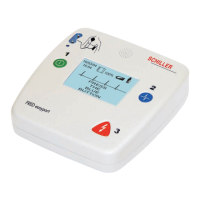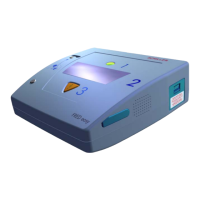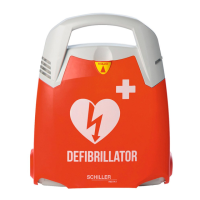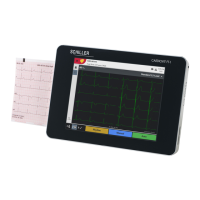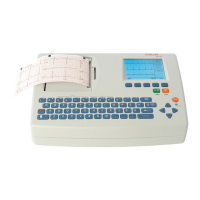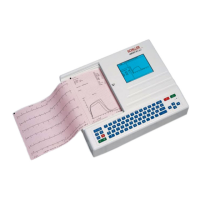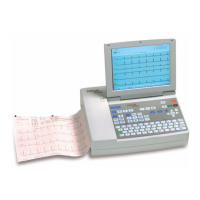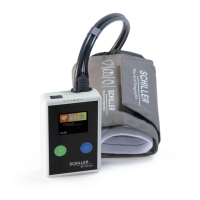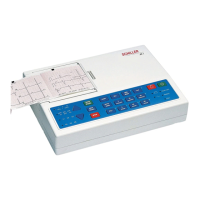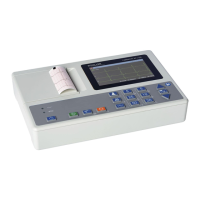Do you have a question about the Schiller FRED easyport plus and is the answer not in the manual?
Defines the types of persons authorized to use the FRED easyport plus.
Describes the device's purpose, patient population, and environmental usage.
Specifies when the FRED easyport plus is intended to be used.
Lists situations or conditions where the device should not be used.
Outlines the user's duties and responsibilities when operating the device.
Covers necessary organizational steps before using the device.
Details critical safety precautions for operating the device.
Discusses potential interference and interaction with other electronic devices.
Provides instructions for servicing and cleaning the device safely.
Lists potential adverse effects of using the defibrillator.
Provides general information and notes about the device's functionality.
Discusses security measures when connecting the device to networks.
Covers implied authorization and warranty terms for the device.
Explains licenses for using the device with replacement parts.
Details the warranty conditions, exclusions, and claims process.
Explains the meaning of symbols used in the user guide for safety.
Details safety symbols and pictograms used within the user guide.
Explains common symbols found directly on the FRED easyport plus device.
Lists and explains symbols related to batteries for the device.
Explains symbols associated with the CS-2 battery charger.
Details symbols found on the packaging of defibrillation electrodes.
Provides an introduction to the FRED easyport plus AED and its use.
Details the technical design and features of the FRED easyport plus.
Describes the defibrillator's core function and electrode use.
Notes the availability of different language options for the device.
Explains the metronome function for CPR guidance.
Describes the CPR feedback feature using ARGUS LifePoint.
Details the device's internal memory for storing intervention data.
Explains how data can be transmitted from the device.
Describes the device's power sources, batteries and their life.
Explains the device's automatic self-testing for readiness.
Lists the different models and versions of the FRED easyport plus.
Summarizes device parameters that can be configured.
Identifies and explains the device's physical operating buttons and indicators.
Provides a visual overview of the AED's interface and its elements.
Illustrates the AED and its accessories when stored in the carrying bag.
Details the information displayed on the device's LCD screen.
Describes the various functions the FRED easyport plus can perform.
Explains the automatic self-test procedure and its significance.
Guides the user through the process of conducting a manual self-test.
Details the steps for performing defibrillation in different modes.
Provides general information and safety notes regarding the device's batteries.
Covers battery types, handling, and essential safety precautions.
Step-by-step instructions for replacing the device battery.
Explains how to power the device on and off, including forced shutdown.
Describes how the device monitors battery status and capacity.
Explains how battery status is indicated when the device is off.
Details low battery notifications when the device is off.
Describes what happens when the battery depletes during operation.
Explains how to check and handle expired defibrillation pads.
Provides tips for maintaining the device's readiness for use.
Explains the types and display of technical notifications from the device.
General instructions and critical safety notes for defibrillation.
Basic instructions on using the defibrillator device.
Specific safety precautions required during defibrillation.
Details electrical shock hazards for users and assistants during defibrillation.
Explains the risk of skin burns and electrode placement guidelines.
Warns about potential pacemaker malfunction and precautions.
Provides specific instructions and precautions for defibrillating children.
General information on applying adhesive electrodes to patients.
Covers electrode application for both adults and children.
Step-by-step guide for unpacking and connecting electrodes.
Detailed instructions on electrode placement for adults and children.
Describes how to check electrode connection and function.
Details the procedure for semi-automatic defibrillation.
Explains the fully automatic defibrillation process.
Describes how automatic AEDs function and guide the user.
Critical safety precautions for automatic defibrillation use.
Step-by-step guide for the automatic defibrillation procedure.
Explains how to activate and use the manual defibrillation mode.
Describes the procedure to switch the device to manual mode.
Instructions for delivering a shock in manual defibrillation mode.
Explains the device's monitoring mode and its usage with Defi-Pads.
Details how to use monitoring mode with the specific Defi-Pads.
Procedures for concluding defibrillation therapy and device shutdown.
Introduces the ARGUS LifePoint sensor for CPR quality monitoring.
Provides details about the ARGUS LifePoint sensor's function and limitations.
Guides the user through the setup and application of the ARGUS LifePoint sensor.
Explains how to access and use the device's transmission menu.
Details the options within the Intervention Management sub-menu.
Step-by-step instructions for transferring data using a USB stick.
Guide for transferring data wirelessly via a Bluetooth bridge.
Explains the automatic data transmission process via Bluetooth.
Provides an overview of the CS-2 battery charger and its components.
Explains the meaning of the LED indicators on the charger.
Details the LED indicators for the rechargeable Lithium Ion battery.
Outlines the recommended intervals for device maintenance and checks.
Lists maintenance tasks and necessary replacements at different intervals.
Specifies the defined service life for the device and its components.
Guide for performing visual checks on the device and accessories.
Instructions for performing functional checks on the device.
Details maintenance requirements for the rechargeable Li-Ion battery.
Details maintenance for the non-rechargeable Lithium/MnO2 battery.
Provides guidelines for cleaning the FRED easyport plus device.
Lists admissible and inadmissible detergents for cleaning the device.
Provides guidelines for disinfecting the FRED easyport plus device.
Lists admissible and inadmissible disinfectants for the device.
Details the process for cleaning and disinfecting specific parts.
Lists available accessories and disposable items for the device.
Provides part numbers and descriptions for ordering accessories.
Lists essential accessories required for the device's operation.
Provides guidelines on how to properly dispose of the device and its components.
Specific instructions for the safe disposal of batteries.
Guidelines for disposing of patient-contacting accessories.
Information on recycling and disposal of the device at end-of-life.
Provides guidance on identifying and resolving common device issues.
Explains how the device notifies users of errors.
Lists common problems, their causes, and remedies.
Details technical notifications and their meanings for troubleshooting.
Offers advice on minimizing electromagnetic interference with the device.
Provides specific actions to prevent electromagnetic interference.
Lists the technical specifications of the FRED easyport plus device.
Specifies the sound level output when the device is ready for shock.
Details the operating, transport, and storage environmental conditions.
Lists the safety standards and classifications the device complies with.
Describes the waveform and characteristics of the defibrillation pulse.
Details the biphasic pulsed waveform used by the device.
Specifies default energy levels for AED mode.
Specifies default energy levels for manual mode.
Details timing for analysis and shock availability in auto modes.
Specifies charging times for manual mode.
Defines the range of patient impedance for shock delivery.
Explains how the device indicates readiness for shock delivery.
Describes the process of shock delivery.
Lists types and specifications of defibrillation electrodes.
Explains the function and performance of the Shock Advisory System (SAS).
Details the Bluetooth specifications and modules used in the device.
Provides technical specifications for the CS-2 charging unit.
Lists technical specifications for the ARGUS LifePoint sensor.
Lists relevant literature and guidelines for cardiopulmonary resuscitation.
Provides definitions for common terms and acronyms used in the manual.
Provides a template for recording device inspection and maintenance checks.
Maps out the device's menu structure and navigation paths.
Details the various settings that can be configured on the device.
Lists configurable parameters for shock energy levels.
Details the configurable settings related to CPR guidance.
Lists configurable parameters for the CPR Feedback feature.
Details settings for device communication, including SDM.
Configurable settings for data transmission modes (Bluetooth, USB).
Lists parameters accessible within the Device Settings menu.
Details system-wide settings like volume, display, and auto-off.
Covers local settings such as language, country, date, and time.
Details base settings like maintenance reminders and unit preferences.
Configuration options for the device's self-test intervals.
Lists various accessories for the FRED easyport plus.
Information on proper disposal methods for batteries.
Details on cleaning procedures for the device.
Covers all aspects related to defibrillation procedures.
General guidelines for disposing of the device and accessories.
Information regarding defibrillation electrodes.
Procedures for ending a defibrillation therapy session.
Procedures for maintaining the FRED easyport plus device.
Important safety information for using the device.
Guidance on solving common problems with the device.
Symbols indicating manufacturer, date, distributor, and importer.
Symbols for medical device, serial, reference, batch, GTIN, quantity, UDI.
Symbols for packaging details, EC REP, and Notified Body.
Symbols for CE marking and Australian regulatory compliance.
Symbols for recyclability, WEEE, and battery disposal prohibition.
Symbols for US sale restriction, RF transmission, and Bluetooth.
Symbols for latex-free, use-by date, and consulting instructions.
Symbols indicating temperature, pressure, and humidity limits.
Symbols for keeping dry, away from sunlight, fragility, and transport orientation.
| Brand | Schiller |
|---|---|
| Model | FRED easyport plus |
| Category | Medical Equipment |
| Language | English |
